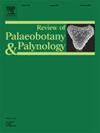Palynology of two drilling cores from the Maniamba Basin, Mozambique (Central Gondwana): Insights on age and palaeoenvironments
IF 1.7
3区 地球科学
Q2 PALEONTOLOGY
引用次数: 0
Abstract
In the present work, dark siltstones, claystones, shales, coals and carbonaceous shale were critically investigated to identify palynofloral assemblages in Mozambiqueʼs overlooked Karoo-aged Maniamba Basin. The study was based on two borehole cores. It unveiled a rich and diversified microflora composed of four distinct palynoassemblages dominated by striate and non-striate bisaccate pollen grains that have prevailed under humid, warm and arid climate conditions in these Gondwana strata. The lower palynoassemblages 1 (P1) and 2 (P2) in both borehole cores are marked by the occurrence of common and abundant striate and non-striate bisaccate pollen, Protohaploxypinus spp., Protohaploxypinus limpidus, Striatopodocarpites cancellatus, Lueckisporites spp., Scheuringipollenites spp. and colpate Cycadopites cymbatus. Late Permian key taxa such as Marsupipollenites triradiatus, Plicatipollenites gondwanensis, and Guttulapollenites hannonicus are found herein. The palynoassemblages 3 (P3) and 4 (P4), were assigned to the Early Triassic based on the FAD of key taxa, chiefly Platysaccus papilonis, Lunatisporites spp., Lundbladispora sp. and Krauselisporites sp. A younger age is assigned to the K5 Formation in the Maniamba Basin correlating well-known Gondwana sequences from the Katberg and Balfour formations from the Main Karoo Basin (South Africa), the Moatize-Minjova Basin (Mozambique), Sakamena Group (Madagascar), Raniganj-Panchet formations (India), Mid-Zambezi valley (Zambia), and the Salt Range Basin (Pakistan). Fossil wood occurrences support the assigned ages. Although other proxies are needed to identify the Permo-Triassic transition, the obtained new palynological data could spark interest in exploring methane associated with coal beds.
莫桑比克(Gondwana中部)Maniamba盆地两个钻孔岩心的孢粉学:对年龄和古环境的认识
在目前的工作中,对莫桑比克被忽视的卡鲁时代的马尼安巴盆地的暗粉砂岩、粘土岩、页岩、煤和碳质页岩进行了严格的研究,以确定孢粉植物组合。这项研究基于两个钻孔岩心。它揭示了一个丰富多样的微生物区系,由四种不同的孢粉组合组成,这些孢粉组合以条纹和非条纹双accate花粉颗粒为主,它们在冈瓦纳地层潮湿、温暖和干旱的气候条件下普遍存在。两个钻孔岩心下部孢粉组合1 (P1)和2 (P2)均有常见且丰富的条纹和非条纹双裂花粉,分别为Protohaploxypinus spp.、Protohaploxypinus limpidus、Striatopodocarpites cancellatus、Lueckisporites spp.、Scheuringipollenites spp.和孢子Cycadopites cymbatus。在此发现了晚二叠世的关键类群,如有袋花粉虫triradiatus、Plicatipollenites gondwanensis和Guttulapollenites hannonicus。根据主要分类群Platysaccus papilonis, Lunatisporites spp, Lundbladispora sp.和Krauselisporites sp.的FAD,将孢粉组合3 (P3)和4 (P4)划分为早三叠世。较年轻的孢粉组合被划分为Maniamba盆地K5组,与南非Main Karoo盆地Katberg组和Balfour组,Moatize-Minjova盆地(莫桑比克),Sakamena Group(马达加斯加)的著名Gondwana序列相对应。Raniganj-Panchet地层(印度),赞比西河中部山谷(赞比亚)和盐岭盆地(巴基斯坦)。化石木材的出现支持指定的年龄。虽然还需要其他指标来确定二叠纪-三叠纪的过渡,但获得的新的孢粉学数据可能会激发人们对探索与煤层相关的甲烷的兴趣。
本文章由计算机程序翻译,如有差异,请以英文原文为准。
求助全文
约1分钟内获得全文
求助全文
来源期刊
CiteScore
3.50
自引率
21.10%
发文量
149
审稿时长
6 months
期刊介绍:
The Review of Palaeobotany and Palynology is an international journal for articles in all fields of palaeobotany and palynology dealing with all groups, ranging from marine palynomorphs to higher land plants. Original contributions and comprehensive review papers should appeal to an international audience. Typical topics include but are not restricted to systematics, evolution, palaeobiology, palaeoecology, biostratigraphy, biochronology, palaeoclimatology, paleogeography, taphonomy, palaeoenvironmental reconstructions, vegetation history, and practical applications of palaeobotany and palynology, e.g. in coal and petroleum geology and archaeology. The journal especially encourages the publication of articles in which palaeobotany and palynology are applied for solving fundamental geological and biological problems as well as innovative and interdisciplinary approaches.

 求助内容:
求助内容: 应助结果提醒方式:
应助结果提醒方式:


